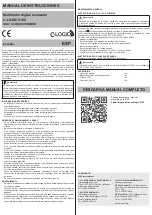
Hanging Up,
You can make the command modem hang up (go On Hook), or
and
go Off Hook, with the
H
command. Entering
ATH1
(upper case)
Bringing the
will bring the line Off Hook just as if you had picked up the
Phone Line
telephone handset. The command modem remains in command
Off Hook
mode.
H0-1
You can hang up by entering
ATH0
or
ATH
(remember that the
default value is 0 when nothing is entered). It is not necessary to
use the
H1
command to
bring the line Off Hook when using the
command modem D command to dial,since the modem will
g o
off hook automatically when you hit
Return at the end of
the Dial command.
Inquiry for
Some
systems
or
software
packages
may
automatically
check
Product
the identification of the modem with which they are communicat-
Code
ing, by using the
I
command. This read command enables the
software to determine the type of modem with which it is commu-
I
nicating.
When
ATI
or
ATI0
(upper case) is entered, the command modem
will respond with xxx,
with the first two digits indicating model, and
the third digit indicating the revision level.
Exiting
You can bring the command modem out of command mode back
Command
into the On-Line Mode, by entering
ATO
(where O is the letter O,
Mode,
not the number 0). In this case, the
O
command reverses what
Going Back
was
done
by
entering
the
Escape
code
(see
Escape
Code
+++
On-LIne
explanation).
O
Pulse or
The
command
modem
will
dial
numbers
using
either
pulse
or
Tone
tone dialing, or in a combination of both methods. Pulse dialing
Dialing
is the method used by rotary-dial telephones, which involve the
timed opening and
closing
of
a
line
relay.
Tone
dialing
is
that
used
P
by push button Touch-Tone telephones, and is sometimes
referred to as DTMF, or
Dual-Tone Multi-Frequency dialing.
T
This is controlled by including a P for Pulse or a T for Tone in the
dialing command, right before the digits you wish to have dialed
in that manner.
For
example,
you
would
pulse-dial
the
number
555-1212
by
entering
ATDP5551212
and
hitting
Return.
You
could
tone-dial
the same number by entering
ATDT5551212
and hitting Return.
If neither Pulse or Tone dialing is specified in the dialing com
mand, the command
modem will use whatever method was last
used. If the modem was reset or just powered up, it will use Pulse
dialing, even if you do not use the letter P in your dial command.
Nearly all telephone systems in the U.S. are now compatible with
tone
dialing.
Since
that
is
the
faster
method,
you
will
probably
choose the tone method for your dialing.
An example of combining pulse and tone dialing could involve a
PBX system where 9 had to be pulse-dialed first, then the rest of
the number tone-dialed after pausing for a second dial tone. The
number would be dialed by entering
ATDP9,T5551212
and
hitting Return. (The
comma causes a pause, which well explain
soon.)
Result Codes
It may be desirable to disable the Result Codes (see V command)
Enabled or
altogether
in
certain
applications,
such
as
computer-controlled
Disabled
auto
dialing.
The
Q
command
is
used
to
do
this,
with
ATQ1
disabling
the
Result
Code
transmissions
and
ATQ0
(or
ATQ)
Q0-1
enabling
them.
If
you
do
not
select
either
method,
the
factory
default setting will enable the Result Codes to be sent.
Forcing an
To
dial
up
another
modem
that
is
in
Originate
mode,
your
Answer
modem must be in Answer mode to initiate the "handshaking"
Tone,
and establishment of a connection. This is done automatically
















































